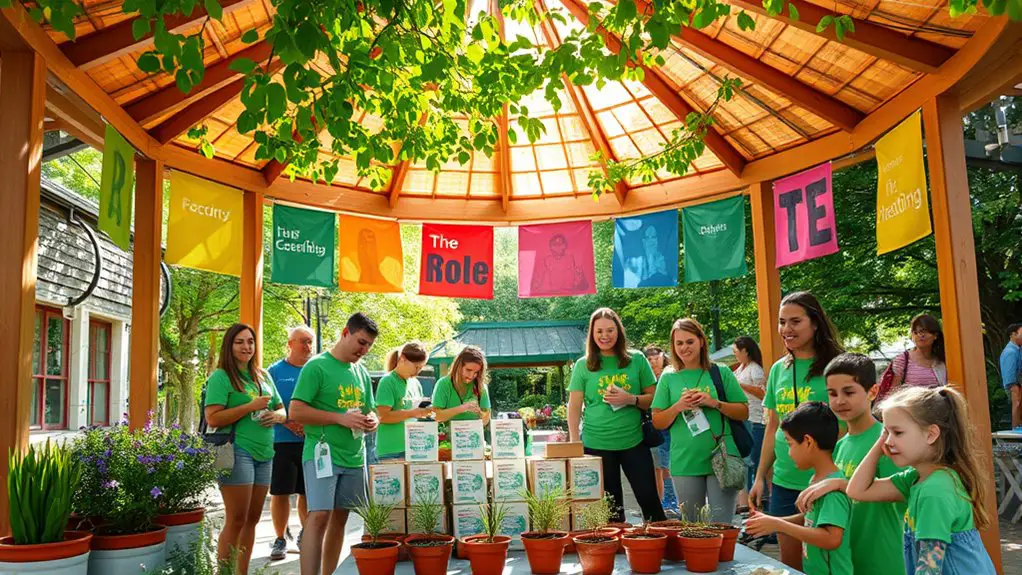Hosting an environmental awareness event in your gazebo can be an inspiring way to connect with your community. Start by choosing a theme that resonates with local concerns, like climate change or wildlife preservation. Incorporate engaging activities, such as recycling workshops or nature scavenger hunts, to educate and empower participants. Collaborate with local environmental groups for expertise and promote your event through social media and community outreach. Together, you can sustain the momentum for meaningful change. Discover more ideas to elevate your event!
Choosing the Right Theme for Your Event
When you’re planning an environmental awareness event, how do you choose the right theme that resonates with your audience? Start by considering current environmental issues that matter most to them—climate change, wildlife preservation, or sustainable living. Your theme selection should spark passion and inspire action. Think about how it can create a sense of community and empowerment among participants. Use surveys or social media polls to gauge interests, ensuring you foster audience engagement from the start. A well-chosen theme not only captures attention but also aligns with your audience’s values and aspirations. Ultimately, the goal is to create an experience that motivates attendees to embrace environmental stewardship and advocate for the change they wish to see.
Engaging Activities and Workshops
To create a truly impactful environmental awareness event, you’ll want to include engaging activities and workshops that encourage participation and foster learning. Consider hosting a recycling workshop where participants can discover innovative ways to repurpose materials, turning waste into art or practical items. This hands-on experience not only educates but ignites creativity.
Additionally, a nature scavenger hunt can be a fun way to connect attendees with the local environment. Provide a list of items to find, encouraging exploration and appreciation of nature’s beauty. These activities not only promote environmental knowledge but also inspire a sense of community. By immersing participants in enjoyable, interactive experiences, your event will resonate long after it ends, empowering individuals to champion environmental causes.
Collaborating With Local Environmental Groups
Collaborating with local environmental groups can greatly enhance your event’s impact, as their expertise and resources often bring valuable insights and support. By establishing partnership strategies, you can tap into their networks and knowledge, ensuring your event resonates with the community. These groups often have a wealth of experience in organizing similar events, which can help you avoid common pitfalls. Additionally, resource sharing can considerably reduce your costs, allowing you to focus on creating an engaging and informative experience. They may provide volunteers, promotional materials, or even guest speakers, enriching your event’s offerings. Embrace this collaboration, and you’ll not only elevate your event but also foster a sense of unity in the shared mission of environmental awareness and action.
Promoting Your Event Effectively
Although planning your event is essential, effectively promoting it is what will draw attendees and create a meaningful impact. Utilize social media platforms to spread the word. Create engaging posts that highlight the importance of environmental awareness, and encourage attendees to share them. Don’t forget community outreach; partner with local businesses and schools to reach wider audiences.
Here’s a simple table to visualize key promotion strategies:
| Strategy | Description | Platforms |
|---|---|---|
| Social Media | Share event details and updates | Facebook, Instagram |
| Flyers & Posters | Distribute in local hotspots | Community centers |
| Email Campaigns | Inform your contacts with invitations | Mailchimp, Gmail |
These strategies will guarantee your event resonates and inspires action.
Sustaining the Momentum Beyond the Event
Once your event wraps up, the real work begins in ensuring that the excitement and awareness generated continue to thrive. Start by launching post-event initiatives that keep the conversation going—like monthly community clean-ups or workshops focused on sustainability. Engage your attendees through social media, sharing photos and stories that highlight their experiences. Encourage them to form small groups dedicated to environmental causes, fostering ongoing community engagement. You can even create a newsletter to share tips and resources, helping everyone stay informed and inspired. Remember, it’s about building a movement, not just hosting an event. By nurturing these connections, you’ll empower individuals to take action, making a lasting impact for the planet and your community.
Frequently Asked Questions
What Permits Do I Need for Hosting an Outdoor Event?
You’ll need event permits based on your location’s regulations. Check for noise regulations, too; they can affect your plans. It’s important to guarantee everything’s compliant, so your event can thrive without interruptions or penalties.
How Can I Ensure Accessibility for All Attendees?
Creating an inclusive space is like planting seeds for a brighter future. Guarantee wheelchair access, provide sign language interpreters, and consider sensory-friendly areas. Everyone deserves to thrive, so make your event welcoming for all.
What Should I Do in Case of Bad Weather?
In case of bad weather, you’ll need a backup plan. Consider securing an alternative venue ahead of time. This guarantees everyone stays dry and comfortable, allowing your event to inspire without interruption, no matter the climate.
How Can I Handle Waste Disposal During the Event?
Think of waste disposal as nurturing a garden; set up recycling stations and compost bins. By guiding attendees to the right place, you’re planting the seeds of environmental responsibility, fostering a community committed to sustainability.
What Safety Measures Should I Implement for Participants?
You should implement emergency protocols, ensuring participant health is prioritized. Have first aid kits ready, establish clear evacuation routes, and communicate safety procedures. Empower everyone to be aware and proactive, fostering a safe, enjoyable atmosphere.

